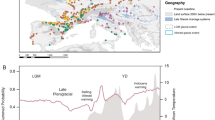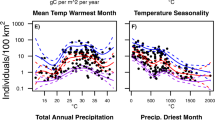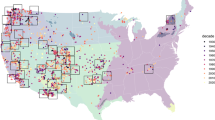Abstract
The dependence of hunter-gatherers on local net primary production (NPP) to provide food played a major role in shaping long-term human population dynamics. Observations of contemporary hunter-gatherers have shown an overall correlation between population density and annual NPP but with a 1,000-fold variation in population density per unit NPP that remains unexplained. Here, we build a process-based hunter-gatherer population model embedded within a global terrestrial biosphere model, which explicitly addresses the extraction of NPP through dynamically allocated hunting and gathering activities. The emergent results reveal a strong, previously unrecognized effect of seasonality on population density via diet composition, whereby hunter-gatherers consume high fractions of meat in regions where growing seasons are short, leading to greatly reduced population density due to trophic inefficiency. This seasonal carnivory bottleneck largely explains the wide variation in population density per unit NPP and questions the prevailing usage of annual NPP as the proxy of carrying capacity for ancient humans. Our process-based approach has the potential to greatly refine our understanding of dynamical responses of ancient human populations to past environmental changes.
This is a preview of subscription content, access via your institution
Access options
Access Nature and 54 other Nature Portfolio journals
Get Nature+, our best-value online-access subscription
$29.99 / 30 days
cancel any time
Subscribe to this journal
Receive 12 digital issues and online access to articles
$119.00 per year
only $9.92 per issue
Buy this article
- Purchase on Springer Link
- Instant access to full article PDF
Prices may be subject to local taxes which are calculated during checkout





Similar content being viewed by others
Data availability
The contemporary hunter-gatherer data and environmental variables used in the analysis are available in the Supplementary Data.
Code availability
Source code (in Python) of the FORGE model and its output files (in NetCDF format) for this study, including the three sets of global simulations (S0, S1, S2), are provided in Supplementary Software. The corresponding input files for the FORGE model are available at https://doi.org/10.6084/m9.figshare.14995320.v2.
References
Binford, L. R. Constructing Frames of Reference: An Analytical Method for Archaeological Theory Building Using Hunter-Gatherer and Environmental Data Sets (Univ. of California Press, 2001).
Kelly, R. L. The Lifeways of Hunter-Gatherers: The Foraging Spectrum (Cambridge Univ. Press, 2013).
Tallavaara, M., Eronen, J. T. & Luoto, M. Productivity, biodiversity, and pathogens influence the global hunter-gatherer population density. Proc. Natl Acad. Sci. USA 115, 1232–1237 (2018).
Eriksson, A. et al. Late Pleistocene climate change and the global expansion of anatomically modern humans. Proc. Natl Acad. Sci. USA 109, 16089–16094 (2012).
Gurven, M. D. & Davison, R. J. Periodic catastrophes over human evolutionary history are necessary to explain the forager population paradox. Proc. Natl Acad. Sci. USA https://doi.org/10.1073/pnas.1902406116 (2019).
Tallavaara, M., Luoto, M., Korhonen, N., Järvinen, H. & Seppä, H. Human population dynamics in Europe over the Last Glacial Maximum. Proc. Natl Acad. Sci. USA 112, 8232–8237 (2015).
Bradshaw, C. J. A. et al. Minimum founding populations for the first peopling of Sahul. Nat. Ecol. Evol. 3, 1057–1063 (2019).
Kavanagh, P. H. et al. Hindcasting global population densities reveals forces enabling the origin of agriculture. Nat. Hum. Behav. 2, 478–484 (2018).
Porter, C. C. & Marlowe, F. W. How marginal are forager habitats? J. Archaeol. Sci. 34, 59–68 (2007).
Reyes-García, V. & Pyhälä, A. Hunter-Gatherers in a Changing World (Springer International Publishing, 2017).
Lee, R. B. & Daly, R. The Cambridge Encyclopedia of Hunters and Gatherers (Cambridge Univ. Press, 1999).
Kitanishi, K. Seasonal changes in the subsistence activities and food intake of the Aka hunter-gatherers in northeastern Congo. Afr. Study Monogr. 16, 73–118 (1995).
Timmermann, A. & Friedrich, T. Late Pleistocene climate drivers of early human migration. Nature 538, 92–95 (2016).
Keeley, L. H. Hunter-gatherer economic complexity and ‘population pressure’: a cross-cultural analysis. J. Anthropol. Archaeol. 7, 373–411 (1988).
Fisher, J. B., Huntzinger, D. N., Schwalm, C. R. & Sitch, S. Modeling the terrestrial biosphere. Annu. Rev. Environ. Resour. 39, 91–123 (2014).
Pachzelt, A., Forrest, M., Rammig, A., Higgins, S. I. & Hickler, T. Potential impact of large ungulate grazers on African vegetation, carbon storage and fire regimes. Glob. Ecol. Biogeogr. 24, 991–1002 (2015).
Zhu, D. et al. The large mean body size of mammalian herbivores explains the productivity paradox during the Last Glacial Maximum. Nat. Ecol. Evol. 2, 640–649 (2018).
Dyble, M., Thorley, J., Page, A. E., Smith, D. & Migliano, A. B. Engagement in agricultural work is associated with reduced leisure time among Agta hunter-gatherers. Nat. Hum. Behav. 3, 792–796 (2019).
Hill, K., Kaplan, H., Hawkes, K. & Hurtado, A. M. Men’s time allocation to subsistence work among the Ache of eastern Paraguay. Hum. Ecol. 13, 29–47 (1985).
Hill, K., Hawkes, K., Hurtado, M. & Kaplan, H. Seasonal variance in the diet of Ache hunter-gatherers in eastern Paraguay. Hum. Ecol. 12, 101–135 (1984).
Marlowe, F. W. et al. Honey, Hadza, hunter-gatherers, and human evolution. J. Hum. Evol. 71, 119–128 (2014).
Cordain, L. et al. Plant–animal subsistence ratios and macronutrient energy estimations in worldwide hunter-gatherer diets. Am. J. Clin. Nutr. 71, 682–692 (2000).
Gurven, M. & Kaplan, H. Longevity among hunter-gatherers: a cross-cultural examination. Popul. Dev. Rev. 33, 321–365 (2007).
Klein Goldewijk, K., Beusen, A. & Janssen, P. Long-term dynamic modeling of global population and built-up area in a spatially explicit way: HYDE 3.1. Holocene 20, 565–573 (2010).
Marlowe, F. W. Hunter-gatherers and human evolution. Evol. Anthropol. 14, 54–67 (2005).
Burger, J. R. & Fristoe, T. S. Hunter-gatherer populations inform modern ecology. Proc. Natl Acad. Sci. USA 115, 1137–1139 (2018).
Hurtado, A. M. & Hill, K. R. Seasonality in a foraging society: variation in diet, work effort, fertility, and sexual division of labor among the Hiwi of Venezuela. J. Anthropol. Res. 46, 293–346 (1990).
Wilmsen, E. N. Studies in diet, nutrition, and fertility among a group of Kalahari Bushmen in Botswana. Soc. Sci. Inf. 21, 95–125 (1982).
Lee, R. B. in Man the Hunter (eds. Lee, R. B. & DeVore, I.) 30–48 (Aldine de Gruyter, 1968).
Hamilton, M. J., Milne, B. T., Walker, R. S. & Brown, J. H. Nonlinear scaling of space use in human hunter-gatherers. Proc. Natl Acad. Sci. USA 104, 4765–4769 (2007).
Messer, E. Anthropological perspectives on diet. Annu. Rev. Anthropol. 13, 205–249 (1984).
Testart, A. et al. The significance of food storage among hunter-gatherers: residence patterns, population densities, and social Inequalities [and Comments and Reply]. Curr. Anthropol. 23, 523–537 (1982).
Winterhalder, B. Diet choice, risk, and food sharing in a stochastic environment. J. Anthropol. Archaeol. 5, 369–392 (1986).
Kelly, R. L., Pelton, S. R. & Robinson, E. in Towards a Broader View of Hunter-Gatherer Sharing (eds Lavi, N. & Friesem, D. E.) Ch. 10 (McDonald Institute for Archaeological Research, 2019).
Joannes-Boyau, R. et al. Elemental signatures of Australopithecus africanus teeth reveal seasonal dietary stress. Nature 572, 112–115 (2019).
Smits, S. A. et al. Seasonal cycling in the gut microbiome of the Hadza hunter-gatherers of Tanzania. Science 357, 802–806 (2017).
Barnosky, A. D. Assessing the causes of Late Pleistocene extinctions on the continents. Science 306, 70–75 (2004).
Henrich, J. Demography and cultural evolution: how adaptive cultural processes can produce maladaptive losses—the Tasmanian case. Am. Antiq. 69, 197–214 (2004).
Powell, A., Shennan, S. & Thomas, M. G. Late Pleistocene demography and the appearance of modern human behavior. Science 324, 1298–1301 (2009).
D’Alpoim Guedes, J. A., Crabtree, S. A., Bocinsky, R. K. & Kohler, T. A. Twenty-first century approaches to ancient problems: climate and society. Proc. Natl Acad. Sci. USA 113, 14483–14491 (2016).
Cegielski, W. H. & Rogers, J. D. Rethinking the role of Agent-based modeling in archaeology. J. Anthropol. Archaeol. 41, 283–298 (2016).
Axtell, R. L. et al. Population growth and collapse in a multiagent model of the Kayenta Anasazi in long house valley. Proc. Natl Acad. Sci. USA 99, 7275–7279 (2002).
Hayden, B. Research and development in the stone age: technological transitions among hunter-gatherers. Curr. Anthropol. 22, 519–548 (1981).
Itkonen, T. I. Suomen Lappalaiset Vuoteen 1945. Ensimmäinen Osa (WSOY, 1848).
Kirby, K. R. et al. D-PLACE: a global database of cultural, linguistic and environmental diversity. PLoS ONE 11, e0158391 (2016).
MODIS NPP (MOD17A3) (NTSG, accessed 12 March 2015); http://files.ntsg.umt.edu/data/NTSG_Products/MOD17/
Defries, R.S. et al. ISLSCP II Continuous Fields of Vegetation Cover, 1992–1993 (ORNL DAAC, 2009); https://doi.org/10.3334/ORNLDAAC/931
Bodesheim, P., Jung, M., Gans, F., Mahecha, M. D. & Reichstein, M. Upscaled diurnal cycles of land–atmosphere fluxes: a new global half-hourly data product. Earth Syst. Sci. Data 10, 1327–1365 (2018).
Šímová, I. & Storch, D. The enigma of terrestrial primary productivity: measurements, models, scales and the diversity–productivity relationship. Ecography 40, 239–252 (2017).
Bontemps, S. et al. Consistent global land cover maps for climate modelling communities: current achievements of The ESA Land Cover CCI. In Proc. ESA Living Planet Symposium 2013 (ESA, 2013).
Bliege Bird, R. & Bird, D. W. Why women hunt—risk and contemporary foraging in a western desert aboriginal community. Curr. Anthropol. 49, 655–693 (2008).
Bliege Bird, R., Codding, B. F. & Bird, D. W. What explains differences in men’s and women’s production? Hum. Nat. 20, 105–129 (2009).
Reyes-García, V., Díaz-Reviriego, I., Duda, R., Fernández-Llamazares, Á. & Gallois, S. ‘Hunting otherwise’—women’s hunting in two contemporary forager-horticulturalist societies. Hum. Nat. 31, 203–221 (2020).
Krinner, G. et al. A dynamic global vegetation model for studies of the coupled atmosphere-biosphere system. Global Biogeochem. Cycles 19, GB1015 (2005).
Hamilton, M. J., Lobo, J., Rupley, E., Youn, H. & West, G. B. The ecological and evolutionary energetics of hunter‐gatherer residential mobility. Evol. Anthropol. 25, 124–132 (2016).
Abrams, P. A. & Ginzburg, L. R. The nature of predation: prey dependent, ratio dependent or neither? Trends Ecol. Evol. 15, 337–341 (2000).
Winterhalder, B., Baillargeon, W., Cappelletto, F., Randolph Daniel, I. & Prescott, C. The population ecology of hunter-gatherers and their prey. J. Anthropol. Archaeol. 7, 289–328 (1988).
Illius, A. W. & O’Connor, T. G. Resource heterogeneity and ungulate population dynamics. Oikos 89, 283–294 (2000).
Golley, F. B. Energy values of ecological materials. Ecology 42, 581–584 (1961).
Herbers, J. M. Time resources and laziness in animals. Oecologia 49, 252–262 (1981).
Raichlen, D. A. et al. Sitting, squatting, and the evolutionary biology of human inactivity. Proc. Natl Acad. Sci. USA https://doi.org/10.1073/pnas.1911868117 (2020).
Abrams, H., Jr. in Food and Evolution (eds Harris, M. & Ross, E.) 207–223 (Temple Univ. Press, 1987).
Hanya, G. & Aiba, S. Fruit fall in tropical and temperate forests: implications for frugivore diversity. Ecol. Res. 25, 1081–1090 (2010).
Gherardi, L. A. & Sala, O. E. Global patterns and climatic controls of belowground net carbon fixation. Proc. Natl Acad. Sci. USA https://doi.org/10.1073/pnas.2006715117 (2020).
van Zonneveld, M. et al. Human diets drive range expansion of megafauna-dispersed fruit species. Proc. Natl Acad. Sci. USA 115, 3326–3331 (2018).
Max R., Hannah R. & Esteban Ortiz-Ospina World Population Growth (GCDL, 2020); https://ourworldindata.org/world-population-growth
Pontzer, H. et al. Metabolic acceleration and the evolution of human brain size and life history. Nature 533, 390 (2016).
Viovy, N. CRUNCEP Version 7—Atmospheric Forcing Data for the Community Land Model (Research Data Archive at the National Center for Atmospheric Research, Computational and Information Systems Laboratory, 2018); https://doi.org/10.5065/PZ8F-F017
Sobol, I. Global sensitivity indices for nonlinear mathematical models and their Monte Carlo estimates. Math. Comput. Simul. 55, 271–280 (2001).
Acknowledgements
D.Z. and E.D.G. acknowledge the financial support from the European Research Council under the European Union’s Horizon 2020 Research and Innovation Programme (agreement no. 682602, to E.D.G.). D.Z. also acknowledges support from the National Natural Science Foundation of China (grant no. 41988101). V.R.-G. acknowledges support from the European Research Council under agreement no. 771056.
Author information
Authors and Affiliations
Contributions
D.Z. and E.D.G. conceived the study and model design. D.Z. built the model, performed the analyses and wrote the first draft. E.D.G. provided discussion and suggestions throughout the process. V.R.-G. and P.C. contributed to the interpretation of the results and writing of the manuscript.
Corresponding author
Ethics declarations
Competing interests
The authors declare no competing interests.
Additional information
Peer review information Nature Ecology & Evolution thanks Trevor Fristoe and the other, anonymous, reviewer(s) for their contribution to the peer review of this work. Peer reviewer reports are available.
Publisher’s note Springer Nature remains neutral with regard to jurisdictional claims in published maps and institutional affiliations.
Supplementary information
Supplementary Information
Supplementary Figs. 1–23, Discussion 1–3 and Tables 1–4.
Supplementary Data
The contemporary hunter-gatherer data and environmental variables used in the analysis.
Supplementary Software
Source code (in Python) of the FORGE model and its output files (in NetCDF format) including the three sets of global simulations (S0, S1, S2).
Rights and permissions
About this article
Cite this article
Zhu, D., Galbraith, E.D., Reyes-García, V. et al. Global hunter-gatherer population densities constrained by influence of seasonality on diet composition. Nat Ecol Evol 5, 1536–1545 (2021). https://doi.org/10.1038/s41559-021-01548-3
Received:
Accepted:
Published:
Issue Date:
DOI: https://doi.org/10.1038/s41559-021-01548-3
This article is cited by
-
Reconstructing colonization dynamics to establish how human activities transformed island biodiversity
Scientific Reports (2024)
-
Climate-driven habitat shifts of high-ranked prey species structure Late Upper Paleolithic hunting
Scientific Reports (2023)
-
Ordinaries 13: apparent spite & apparent altruism
Journal of Bioeconomics (2023)
-
Sociality predicts orangutan vocal phenotype
Nature Ecology & Evolution (2022)
-
Changes in limiting factors for forager population dynamics in Europe across the last glacial-interglacial transition
Nature Communications (2022)



